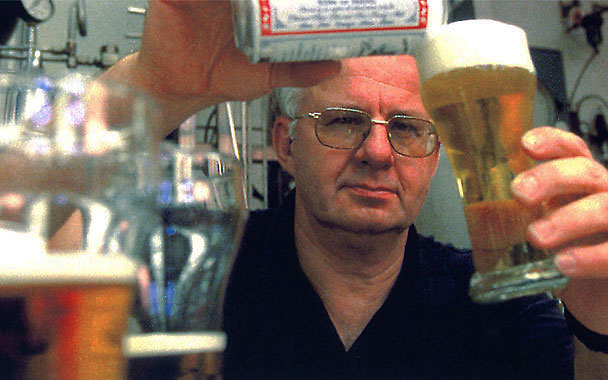Call Charles Bamforth a beer evangelist. For 30-plus years, the British-born professor has obsessed about suds, spending the early years of his career toiling as a yeast researcher and overseeing quality assurance at a Bass brewery. He currently—and perhaps ironically—works at a famed winemaking school: the University of California at Davis. In addition to serving as chairman of the department of food science and technology, Bamforth is the Anheuser-Busch Endowed Professor of Brewing Science, overseeing one of the only university-accredited brewing programs in the U.S. (the other is at Oregon State; trade schools also offer brewing courses). The professor of beer, who pitted wine against beer in his recent book Grape vs. Grain, talked with Joshua M. Bernstein about the problem with insanely hoppy beers; brewers’ biggest mistakes; and why restaurateurs should be sent to Belgium.
Joshua M. Bernstein: Tell us about your three beer-centric classes.
Charles Bamforth: Introduction to Beer and Brewing discusses the history of beer, the business of brewing and basic science. In Malting and Brewing Science, I teach the detailed science and technology of brewing. Beer is sublime biochemistry, and to understand what you’re doing you have to understand the science.
In Practical Malting and Brewing, students make a low-bitterness beer called Aggie’s Ale—named after the Davis mascot—then tweak that to understand the impact of, say, changing hops’ strength. Lastly, they design weird and wonderful beers.
JMB: What do they make?
CB: I tell my students the hardest beers to make are the gentlest, because you can’t mask defects. So students make the darkest, hoppiest beer possible. Beers such as North American lagers have relatively subtle flavors. As a consequence, any defects are more glaring in those beers than in very heavily flavored beers, such as stouts. This is why freshness is so important in North America—aging characteristics will display themselves most obviously in a North American lager.
JMB: Can beers be too bold?
CB: Outrageously hoppy beers are too challenging to drink because they’re too bitter—a beer should have drinkability. When you sip it you should think, Wow, I enjoyed that. I should have another one.
JMB: Do you convert any wine students to brewing?
CB: I pride myself on converting at least one winemaker a year to the noble beverage. There’s a charm to Sonoma and the Napa Valley, but charm only goes so far. With a greater range of raw materials, plus a seasonal rotation of styles, making beer is much more complicated and rewarding than making wine. I jokingly tell students, “You only have red, white, and pink wine, but there are endless varieties of beer.”
JMB: How else do wine makers and brewers differ?
CB: Brewers tend to use unappealing terms like catty, grainy and burnt, while wine guys tend to use more charming terms, like fruity. If brewers can learn some of the lexicon, we can make some of the terms more appealing. For instance, I don’t think catty is very attractive. When beer ages, it can develop a tomcat-urine flavor. Instead of saying, “This beer tastes like tomcat urine,” perhaps we can substitute the more appealing and equally accurate, “This beer tastes like black-currant buds.”
JMB: What’s home brewers’ biggest mistake?
CB: The golden rule is hygiene, hygiene, hygiene. Brewing equipment must be scrupulously clean. I’m also a great believer in using high-quality yeast. The yeast has a direct influence on flavor: For example, fruity aromas come from the yeast. From experience, I’ve found that the liquid forms of yeast give the best performance.



 Pinterest
Pinterest


